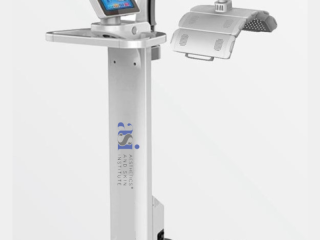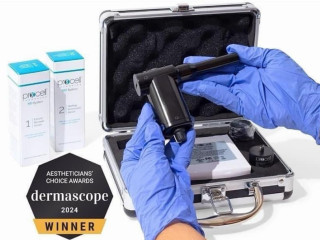Skintech Pro Skin Lesion RF Machine
Sep 24th, 2024 at 03:13 Aesthetic Machines Melbourne 104 views Reference: 20Location: Melbourne
Price: $2,599
Introducing the Skintech Pro RF Skin Lesion removal machine, effectively addresses a broad range of skin lesions using advanced radio frequency technology. This non-invasive, high-precision method delivers immediate results.
Product Overview
- Skintech Pro, designed by ASI, is one of the most essential machines for a skin clinics.
- It is a radiofrequency device that works by electro-desiccation for the removal of benign skin lesions.
Key Benefits
- Simple to operate, no consumables, good ROI.
- Affordable.
- Short treatment time.
- Minimal risks of scarring, easy to operate.
- Minimal training is required.
What does the device remove ?
- Skin tags
- eborrhoeic Keratosis
- Dermatosis Papulosa Nigra
- Sebaceous Hyperplasia
- Cherry angioma
- Telangiectasis, especially in nasal areas
- Lentigenes
- Ephiledes (freckles)
- Milia
- Pustular acne lesions
- Fibromas on the nose
How does it work?
This radiofrequency device works by electrodessication.
What are the side effects?
The most common side effects after treatment are a bit of redness, tenseness, and swelling localized to the area that has been treated.
What is the downtime?
Scabbing is expected, which could last up to 7-10 days.
Is it painful?
Some patients may prefer the application of topical anesthetic creams prior to the procedure.
What can’t it treat?
It is not suitable for scars, syringomas, or xanthelasma.
What about pregnancy?
We do not recommend using the tool for those who are pregnant, have skin infections, or contagious skin disorders.
Aftercare
The lesion is allowed to scab, which should fall off 5-7 days later.
Immediately following the procedure, an antiseptic cream or white petrolatum is applied to the area.
Keep the area dry by not washing it for 24 to 48 hours.
After this time, gentle soap and water can be used to cleanse the area.
Sun protection is necessary.
Expect post-inflammatory hyperpigmentation in skin type 4-6 patients; a pigmentation cream may be necessary to prevent post-inflammatory hyperpigmentation.
Infection is also unlikely, although all surgical procedures are associated with some degree of infection risk, which is why patients are asked to strictly follow the wound care instructions they are given.
Other precautions:
Avoid using harsh or exfoliating skincare products on the treated area for 7 days after.
Avoid saunas, intense exercise, and any other high-temperature environments or intense activities for 2 days post-treatment.
Avoid picking at the skin.
You may wet the area but apply some protective cream before and after showering if necessary.
What is the downtime?
Patients should expect the recovery period after treatment to take two to five days. Minor redness may occur at the treatment site, but this will quickly diminish as the blemish fades. No downtime is required after the procedure; patients can immediately return to work or school without restrictions.
Can it cause scarring?
The risk of scarring is minimal.
The procedure
The skin area concerned is cleaned using an alcohol wipe, and numbing cream is administered if necessary.
Turn the power on.
Set the power to a lower setting and then gradually increase the power if necessary.
Allow the probe to touch the lesion.
The endpoint is when the lesion turns grey.
Training
A complementary online module is available, and medical support is provided. Hands-on training is also provided if required.
Clients should be familiar with the diagnosis of benign skin lesions.
Repeated treatments may be necessary for large and thick seborrhoeic keratosis.
FAQs
How is this different from electrocautery?
Electrocautery and electrodessication are two different techniques used in medical procedures:
Electrocautery involves using a high-frequency electric current to cut or coagulate tissue. It is commonly used to control bleeding during surgery, remove abnormal tissue growths, and seal off blood vessels. If used to remove lesions, the heat can cause scarring.
Electrodessication, on the other hand, uses a lower power electric current to “dry out” and destroy tissue.
In summary, electrocautery is typically used for cutting and coagulating tissue, while electrodessication is used for drying out and destroying tissue.
Comparison to CO2
When comparing CO2 laser with Skintech Pro (radiofrequency) for the removal of benign skin lesions, both methods work by causing the cells to vaporize, though through different mechanisms.
Advantages of radiofrequency over CO2 laser:
1. Control:
Radiofrequency equipment is more compact and resembles a pen, making it easier to handle and control with precision. This allows for more accurate depth control and targeted removal of unwanted tissues. The risk of scarring is minimal with Skintech Pro.
2. Precision:
The pinpoint accuracy of the Skintech Pro pen allows for precise and controllable depth of treatment compared to the wider CO2 beam, making it easier to operate and minimizing the risk of scarring.
3. Cost:
Radiofrequency machines are significantly more affordable than CO2 lasers and require less maintenance due to their simpler design. This makes radiofrequency machines a cost-effective and durable option for skin clinics.
Caution
Electrodessication can potentially cause pacemakers to dysfunction, and the procedure is not usually recommended for patients with implanted electrical devices.






